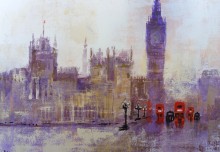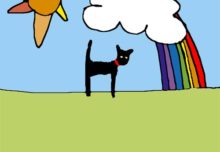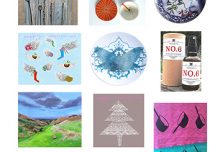GICLEE PRINTS. The best thing since sliced bread.
Giclee is the best thing since sliced bread, or is it? Some artists will already have shut down their computer and stomped out of the room in disgust at the first mention of giclee. Others will be nodding in agreement if I say that giclee has changed the modern artists potential as no other.
So what is giclee and why is it so controversial? Basically it is a type of printing that uses digital technology. It is the same sort of system as an ordinary desktop printer that many of us have at home or in the office. Except that a giclee printer is bigger, and it can print onto archival quality, heavyweight fine-art paper, or even fine art canvas, fed in from a roll. The rolls, and printers, are available in a range of widths, 13”, 24”, 44”, or 60”.
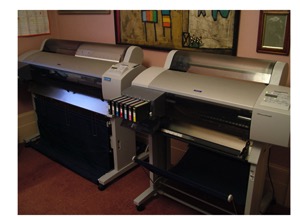
44″ and 24″ Epson Stylus Pro printers
The other important factor is the quality of inks that are used. It is crucial that the inks are pigmented and not dye based, meaning that they will not fade away at the first hint of sunlight like a desktop home printer. Your desktop printer will probably have three colours and black. The modern giclee printer will have up to a dozen different pigmented colour cartridges. Earlier versions had seven including two blacks so that photographs could be printed onto glossy photography paper, or matt black for heavy paper and canvas. There is not much dispute over the fact that giclee technology makes very high quality prints.
The difference of opinion comes along because artists can use giclee technology to make prints that are reproductions of paintings. The process is like this;
1.Paint a picture using oil, acrylics, pastel, watercolour etc.
2. Photograph or scan the painting to make a digital file.
3. Print the file using a giclee quality printer.
So you have a print of a painting. It looks like the painting but it is a print.
The case for and against.
The traditional printmaker artist believes that ‘prints’ should be exclusively ‘original prints’ and not just reproductions. So long established methods for printmaking like lithography, etching, engraving, lino-cuts even, are seen to be good. Whilst mere repros using photography to capture a painting are seen as something close to mortal sin.
I recall a meeting that I attended between the Fine Art Trade Guild on one side and the Printmakers Council on the other. The Guild represented artists and publishers, the Council represented traditional printmakers. The printmakers wanted all Guild publishers to label any giclee prints as ‘reproductions’.
The publishers demurred arguing that the printmakers were Luddites failing to recognize that their traditional ways were equalled, or even surpassed in quality, and that they were trying to hold back the tide like Canute. [Sorry for the mixed metaphor.] They argued that some artists had always objected to new ways of making art. Camera obscura is the classic example. These very same printmakers had even argued against screenprints only a few decades previously and now they accepted screenprints, and claimed screenprinting for themselves.
Why are giclee prints so popular with publishers? The main benefit of the technology is that it is digital, meaning that the image is stored on a computer after it has been created. This enables ‘print on demand’. So whenever the publisher or artist wants a print they can access the image file and press the print button. There is no over production, hence a great deal less wastage. The image can be printed in a range of different sizes, on paper or canvas. This means that that there is much wider choice available for art collectors. And the quality is as good as it gets. In fact probably better than ever before in terms of lightfasteness, reliability, and depth of colour.
The printmakers argued that the crucial point was the artists ‘purpose’. If the artist makes a print using traditional printmaking method, then he or she knows and wants to make prints. They may make artwork roughs before creating the plates or screens that they will use to make a series of prints. But the artist has a printmaking purpose whatever their method.
Whereas the wicked publisher is just making copies of artworks that were made with a different purpose.
However their argument had a flaw. What if the artist painted the picture with the intention of the image becoming a print? At the meeting a top Guild publisher cited instances where they have regularly commissioned artwork from painters with the express intention of making prints from the image.
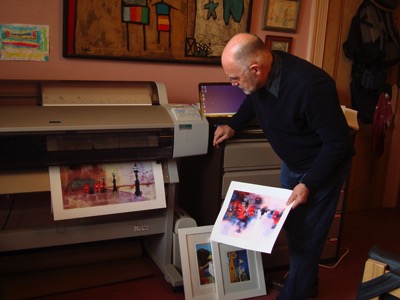
CR printing on Epson
Conclusion.
That meeting broke up without a winner but we all had taken on board the other sides argument. Alas the controversy continues today.
My own position is that I really like the process of painting pictures. I like sploshing paint onto canvas and getting that painterly effect. I can then capture that picture by scanning or photographing the image. Then there is also the bonus afterwards if I use digital tools to do extra digital things to the image. That can greatly improve the picture.
But I also like making prints because I have found that it makes so much economic sense. You can only sell an original painting once, which makes a big difference to the price that you have got to ask. Whereas a print can be produced at a very affordable price-point!
I made lithographs and silkscreen prints until something much better came along. That was giclee! I have a personal experience of print making success when I have made giclee prints based on my painted images. For the last twenty years all my paintings have been made with the intent and extra purpose of publishing editions. For many artists like me printmaking is integral to the creative process.
My collectors like my prints as well.
I hope that helps.


